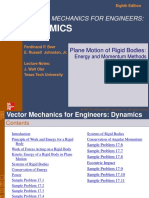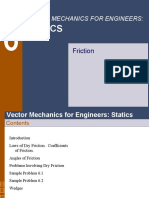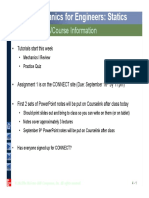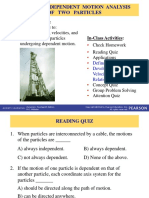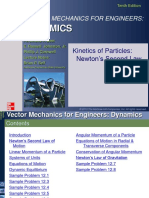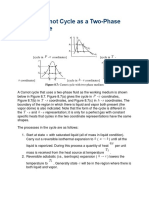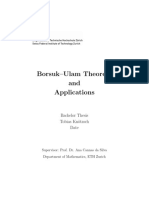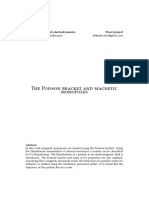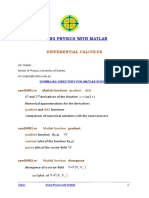Dynamics: Vector Mechanics For Engineers
Uploaded by
Akatew Haile MebrahtuDynamics: Vector Mechanics For Engineers
Uploaded by
Akatew Haile MebrahtuVECTOR MECHANICS FOR ENGINEERS:
DYNAMICS
Tenth Edition
Ferdinand P. Beer
E. Russell Johnston, Jr.
Phillip J. Cornwell
Lecture Notes:
Brian P. Self
California Polytechnic State University
CHAPTER
2013 The McGraw-Hill Companies, Inc. All rights reserved.
12
Kinetics of Particles:
Newtons Second Law
2013 The McGraw-Hill Companies, Inc. All rights reserved.
Vector Mechanics for Engineers: Dynamics
T
e
n
t
h
E
d
i
t
i
o
n
Contents
12 - 2
Introduction
Newtons Second Law of
Motion
Linear Momentum of a Particle
Systems of Units
Equations of Motion
Dynamic Equilibrium
Sample Problem 12.1
Sample Problem 12.3
Sample Problem 12.4
Sample Problem 12.5
Sample Problem 12.6
Angular Momentum of a Particle
Equations of Motion in Radial &
Transverse Components
Conservation of Angular Momentum
Newtons Law of Gravitation
Sample Problem 12.7
Sample Problem 12.8
Trajectory of a Particle Under a
Central Force
Application to Space Mechanics
Sample Problem 12.9
Keplers Laws of Planetary Motion
2013 The McGraw-Hill Companies, Inc. All rights reserved.
Vector Mechanics for Engineers: Dynamics
T
e
n
t
h
E
d
i
t
i
o
n
Kinetics of Particles
2 - 3
We must analyze all of the forces
acting on the wheelchair in order
to design a good ramp
High swing velocities can
result in large forces on a
swing chain or rope, causing
it to break.
2013 The McGraw-Hill Companies, Inc. All rights reserved.
Vector Mechanics for Engineers: Dynamics
T
e
n
t
h
E
d
i
t
i
o
n
Introduction
12 - 4
Newtons Second Law of Motion
m E = F a
If the resultant force acting on a particle is not
zero, the particle will have an acceleration
proportional to the magnitude of resultant
and in the direction of the resultant.
Must be expressed with respect to a Newtonian (or inertial)
frame of reference, i.e., one that is not accelerating or rotating.
This form of the equation is for a constant mass system
2013 The McGraw-Hill Companies, Inc. All rights reserved.
Vector Mechanics for Engineers: Dynamics
T
e
n
t
h
E
d
i
t
i
o
n
Linear Momentum of a Particle
12 - 5
Replacing the acceleration by the derivative of the velocity
yields
( )
particle the of momentum linear =
= =
=
L
dt
L d
v m
dt
d
dt
v d
m F
Linear Momentum Conservation Principle:
If the resultant force on a particle is zero, the linear momentum
of the particle remains constant in both magnitude and direction.
2013 The McGraw-Hill Companies, Inc. All rights reserved.
Vector Mechanics for Engineers: Dynamics
T
e
n
t
h
E
d
i
t
i
o
n
Systems of Units
12 - 6
Of the units for the four primary dimensions (force,
mass, length, and time), three may be chosen arbitrarily.
The fourth must be compatible with Newtons 2nd Law.
International System of Units (SI Units): base units are
the units of length (m), mass (kg), and time (second).
The unit of force is derived,
( )
2 2
s
m kg
1
s
m
1 kg 1 N 1
= |
.
|
\
|
=
U.S. Customary Units: base units are the units of force
(lb), length (m), and time (second). The unit of mass is
derived,
ft
s lb
1
s ft 1
lb 1
slug 1
s ft 32.2
lb 1
lbm 1
2
2 2
= = =
2013 The McGraw-Hill Companies, Inc. All rights reserved.
Vector Mechanics for Engineers: Dynamics
T
e
n
t
h
E
d
i
t
i
o
n
Equations of Motion
12 - 7
Newtons second law
a m F
Can use scalar component equations, e.g., for
rectangular components,
( ) ( )
z m F y m F x m F
ma F ma F ma F
k a j a i a m k F j F i F
z y x
z z y y x x
z y x z y x
= = =
= = =
+ + = + +
2013 The McGraw-Hill Companies, Inc. All rights reserved.
Vector Mechanics for Engineers: Dynamics
T
e
n
t
h
E
d
i
t
i
o
n
Dynamic Equilibrium
12 - 8
Alternate expression of Newtons second law,
ector inertial v a m
a m F
0
=
With the inclusion of the inertial vector, the system
of forces acting on the particle is equivalent to
zero. The particle is in dynamic equilibrium.
Methods developed for particles in static
equilibrium may be applied, e.g., coplanar forces
may be represented with a closed vector polygon.
Inertia vectors are often called inertial forces as
they measure the resistance that particles offer to
changes in motion, i.e., changes in speed or
direction.
Inertial forces may be conceptually useful but are
not like the contact and gravitational forces found
in statics.
2013 The McGraw-Hill Companies, Inc. All rights reserved.
Vector Mechanics for Engineers: Dynamics
T
e
n
t
h
E
d
i
t
i
o
n
Free Body Diagrams and Kinetic Diagrams
12 - 9
The free body diagram is the same as you have done in statics; we
will add the kinetic diagram in our dynamic analysis.
2. Draw your axis system (e.g., Cartesian, polar, path)
3. Add in applied forces (e.g., weight, 225 lb pulling force)
4. Replace supports with forces (e.g., normal force)
1. Isolate the body of interest (free body)
5. Draw appropriate dimensions (usually angles for particles)
x
y
225 N
F
f
N
mg
25
o
2013 The McGraw-Hill Companies, Inc. All rights reserved.
Vector Mechanics for Engineers: Dynamics
T
e
n
t
h
E
d
i
t
i
o
n
Free Body Diagrams and Kinetic Diagrams
12 - 10
Put the inertial terms for the body of interest on the kinetic diagram.
2. Draw in the mass times acceleration of the particle; if unknown,
do this in the positive direction according to your chosen axes
1. Isolate the body of interest (free body)
x
y
225 N
F
f
N
mg
25
o
ma
y
ma
x
m E = F a
=
2013 The McGraw-Hill Companies, Inc. All rights reserved.
Vector Mechanics for Engineers: Dynamics
T
e
n
t
h
E
d
i
t
i
o
n
Free Body Diagrams and Kinetic Diagrams
2 - 11
Draw the FBD and KD for block A (note that the
massless, frictionless pulleys are attached to block A
and should be included in the system).
2013 The McGraw-Hill Companies, Inc. All rights reserved.
Vector Mechanics for Engineers: Dynamics
T
e
n
t
h
E
d
i
t
i
o
n
Free Body Diagrams and Kinetic Diagrams
2 - 12
1. Isolate body
2. Axes
3. Applied forces
4. Replace supports with forces
5. Dimensions (already drawn)
x
y
mg
F
f-1
N
1
T
T
T
T
T
F
f-B
N
B
ma
y
= 0
ma
x
6. Kinetic diagram
=
2013 The McGraw-Hill Companies, Inc. All rights reserved.
Vector Mechanics for Engineers: Dynamics
T
e
n
t
h
E
d
i
t
i
o
n
Free Body Diagrams and Kinetic Diagrams
2 - 13
Draw the FBD and KD for the collar B. Assume
there is friction acting between the rod and collar,
motion is in the vertical plane, and u is increasing
2013 The McGraw-Hill Companies, Inc. All rights reserved.
Vector Mechanics for Engineers: Dynamics
T
e
n
t
h
E
d
i
t
i
o
n
Free Body Diagrams and Kinetic Diagrams
2 - 14
1. Isolate body
2. Axes
3. Applied forces
4. Replace supports with forces
5. Dimensions
6. Kinetic diagram
mg
F
f
N
ma
r
ma
u
e
u
e
r
=
u
u
2013 The McGraw-Hill Companies, Inc. All rights reserved.
Vector Mechanics for Engineers: Dynamics
T
e
n
t
h
E
d
i
t
i
o
n
Sample Problem 12.1
12 - 15
A 200-lb block rests on a horizontal
plane. Find the magnitude of the force
P required to give the block an
acceleration of 10 ft/s
2
to the right. The
coefficient of kinetic friction between
the block and plane is
k
= 0.25.
SOLUTION:
Resolve the equation of motion for the
block into two rectangular component
equations.
Unknowns consist of the applied force
P and the normal reaction N from the
plane. The two equations may be
solved for these unknowns.
2013 The McGraw-Hill Companies, Inc. All rights reserved.
Vector Mechanics for Engineers: Dynamics
T
e
n
t
h
E
d
i
t
i
o
n
Sample Problem 12.1
12 - 16
N
N F
g
W
m
k
25 . 0
ft
s lb
21 . 6
s ft 2 . 32
lb 200
2
2
=
=
=
= =
x
y
O
SOLUTION:
Resolve the equation of motion for the block
into two rectangular component equations.
: ma F
x
=
( )( )
lb 1 . 62
s ft 10 ft s lb 21 . 6 25 . 0 30 cos
2 2
=
= N P
: 0 =
y
F
0 lb 200 30 sin = P N
Unknowns consist of the applied force P and
the normal reaction N from the plane. The two
equations may be solved for these unknowns.
( ) lb 1 . 62 lb 200 30 sin 25 . 0 30 cos
lb 200 30 sin
= +
+ =
P P
P N
lb 151 = P
2013 The McGraw-Hill Companies, Inc. All rights reserved.
Vector Mechanics for Engineers: Dynamics
T
e
n
t
h
E
d
i
t
i
o
n
Sample Problem 12.3
12 - 17
The two blocks shown start from rest.
The horizontal plane and the pulley are
frictionless, and the pulley is assumed
to be of negligible mass. Determine
the acceleration of each block and the
tension in the cord.
SOLUTION:
Write the kinematic relationships for the
dependent motions and accelerations of
the blocks.
Write the equations of motion for the
blocks and pulley.
Combine the kinematic relationships
with the equations of motion to solve for
the accelerations and cord tension.
2013 The McGraw-Hill Companies, Inc. All rights reserved.
Vector Mechanics for Engineers: Dynamics
T
e
n
t
h
E
d
i
t
i
o
n
Sample Problem 12.3
12 - 18
Write equations of motion for blocks and pulley.
:
A A x
a m F =
( )
A
a T kg 100
1
=
:
B B y
a m F =
( )( ) ( )
( )
B
B
B B B
a T
a T
a m T g m
kg 300 - N 2940
kg 300 s m 81 . 9 kg 300
2
2
2
2
=
=
=
: 0 = =
C C y
a m F
0 2
1 2
= T T
SOLUTION:
Write the kinematic relationships for the dependent
motions and accelerations of the blocks.
A B A B
a a x y
2
1
2
1
= =
x
y
O
2013 The McGraw-Hill Companies, Inc. All rights reserved.
Vector Mechanics for Engineers: Dynamics
T
e
n
t
h
E
d
i
t
i
o
n
Sample Problem 12.3
12 - 19
( )
N 1680 2
N 840 kg 100
s m 20 . 4
s m 40 . 8
1 2
1
2
2
1
2
= =
= =
= =
=
T T
a T
a a
a
A
A B
A
Combine kinematic relationships with equations of
motion to solve for accelerations and cord tension.
A B A B
a a x y
2
1
2
1
= =
( )
A
a T kg 100
1
=
( )
( )( )
A
B
a
a T
2
1
2
kg 300 - N 2940
kg 300 - N 2940
=
=
( ) ( ) 0 kg 100 2 kg 150 N 2940
0 2
1 2
=
=
A A
a a
T T
x
y
O
2013 The McGraw-Hill Companies, Inc. All rights reserved.
Vector Mechanics for Engineers: Dynamics
T
e
n
t
h
E
d
i
t
i
o
n
Sample Problem 12.4
12 - 20
The 12-lb block B starts from rest and
slides on the 30-lb wedge A, which is
supported by a horizontal surface.
Neglecting friction, determine (a) the
acceleration of the wedge, and (b) the
acceleration of the block relative to the
wedge.
SOLUTION:
The block is constrained to slide down
the wedge. Therefore, their motions are
dependent. Express the acceleration of
block as the acceleration of wedge plus
the acceleration of the block relative to
the wedge.
Write the equations of motion for the
wedge and block.
Solve for the accelerations.
2013 The McGraw-Hill Companies, Inc. All rights reserved.
Vector Mechanics for Engineers: Dynamics
T
e
n
t
h
E
d
i
t
i
o
n
Sample Problem 12.4
12 - 21
SOLUTION:
The block is constrained to slide down the
wedge. Therefore, their motions are dependent.
A B A B
a a a
+ =
Write equations of motion for wedge and block.
x
y
:
A A x
a m F =
( )
A A
A A
a g W N
a m N
=
=
1
1
5 . 0
30 sin
( ): 30 cos
A B A B x B x
a a m a m F = =
( )( )
+ =
=
30 sin 30 cos
30 cos 30 sin
g a a
a a g W W
A A B
A B A B B
( ): 30 sin = =
A B y B y
a m a m F
( ) = 30 sin 30 cos
1 A B B
a g W W N
2013 The McGraw-Hill Companies, Inc. All rights reserved.
Vector Mechanics for Engineers: Dynamics
T
e
n
t
h
E
d
i
t
i
o
n
Sample Problem 12.4
12 - 22
( )
A A
a g W N =
1
5 . 0
Solve for the accelerations.
( )
( ) ( )
( )( )
( ) ( ) +
=
+
=
=
=
30 sin lb 12 lb 30 2
30 cos lb 12 s ft 2 . 32
30 sin 2
30 cos
30 sin 30 cos 2
30 sin 30 cos
2
1
A
B A
B
A
A B B A A
A B B
a
W W
gW
a
a g W W a g W
a g W W N
2
s ft 07 . 5 =
A
a
( ) ( ) + =
+ =
30 sin s ft 2 . 32 30 cos s ft 07 . 5
30 sin 30 cos
2 2
A B
A A B
a
g a a
2
s ft 5 . 20 =
A B
a
2013 The McGraw-Hill Companies, Inc. All rights reserved.
Vector Mechanics for Engineers: Dynamics
T
e
n
t
h
E
d
i
t
i
o
n
Group Problem Solving
2 - 23
The two blocks shown are originally at
rest. Neglecting the masses of the pulleys
and the effect of friction in the pulleys and
between block A and the horizontal
surface, determine (a) the acceleration of
each block, (b) the tension in the cable.
SOLUTION:
Write the kinematic relationships for the
dependent motions and accelerations of
the blocks.
Write the equations of motion for the
blocks and pulley.
Combine the kinematic relationships
with the equations of motion to solve for
the accelerations and cord tension.
Draw the FBD and KD for each block
2013 The McGraw-Hill Companies, Inc. All rights reserved.
Vector Mechanics for Engineers: Dynamics
T
e
n
t
h
E
d
i
t
i
o
n
Group Problem Solving
2 - 24
x
A
y
B
const nts 3 a
A B
x y L + + =
3 0
A B
v v + =
3 0
A B
a a + =
3
A B
a a =
SOLUTION:
Write the kinematic relationships for the
dependent motions and accelerations of
the blocks.
This is the same problem worked last
chapter- write the constraint equation
Differentiate this twice to get the
acceleration relationship.
(1)
2013 The McGraw-Hill Companies, Inc. All rights reserved.
Vector Mechanics for Engineers: Dynamics
T
e
n
t
h
E
d
i
t
i
o
n
Group Problem Solving
2 - 25
: E =
x A A
F m a
=
A B
T m a
3
A B
T m a =
y B B
F m a E =
3(3 )
B A B B B
m g m a m a =
2
2
9.81 m/s
0.83136 m/s
30 kg
1 9 1 9
25 kg
B
A
B
g
a
m
m
= = =
+ +
2
2.49 2.49 m/s
A
= = a
2
3 30 kg 0.83136 m/s T =
74.8 N T =
Draw the FBD and KD for each block
m
A
g
T
N
A
ma
Ax
m
B
g
2T
T
ma
By
Write the equation of motion for each block
=
=
From Eq (1)
(2)
(3)
3
B B B
W T m a =
(2) (3)
B
A
Solve the three equations, 3 unknowns
+y
+x
2013 The McGraw-Hill Companies, Inc. All rights reserved.
Vector Mechanics for Engineers: Dynamics
T
e
n
t
h
E
d
i
t
i
o
n
Concept Quiz
2 - 26
The three systems are released from rest. Rank the
accelerations, from highest to lowest.
a) (1) > (2) > (3)
b) (1) = (2) > (3)
c) (2) > (1) > (3)
d) (1) = (2) = (3)
e) (1) = (2) < (3)
(1) (2) (3)
2013 The McGraw-Hill Companies, Inc. All rights reserved.
Vector Mechanics for Engineers: Dynamics
T
e
n
t
h
E
d
i
t
i
o
n
Kinetics: Normal and Tangential Coordinates
2 - 27
Aircraft and roller coasters can both experience large
normal forces during turns.
2013 The McGraw-Hill Companies, Inc. All rights reserved.
Vector Mechanics for Engineers: Dynamics
T
e
n
t
h
E
d
i
t
i
o
n
Equations of Motion
12 - 28
For tangential and normal components,
t t
t
F ma
dv
F m
dt
=
=
Newtons second law
a m F
2
n n
n
F ma
v
F m
=
=
2013 The McGraw-Hill Companies, Inc. All rights reserved.
Vector Mechanics for Engineers: Dynamics
T
e
n
t
h
E
d
i
t
i
o
n
Sample Problem 12.5
12 - 29
The bob of a 2-m pendulum describes
an arc of a circle in a vertical plane. If
the tension in the cord is 2.5 times the
weight of the bob for the position
shown, find the velocity and accel-
eration of the bob in that position.
SOLUTION:
Resolve the equation of motion for the
bob into tangential and normal
components.
Solve the component equations for the
normal and tangential accelerations.
Solve for the velocity in terms of the
normal acceleration.
2013 The McGraw-Hill Companies, Inc. All rights reserved.
Vector Mechanics for Engineers: Dynamics
T
e
n
t
h
E
d
i
t
i
o
n
Sample Problem 12.5
12 - 30
SOLUTION:
Resolve the equation of motion for the bob into
tangential and normal components.
Solve the component equations for the normal and
tangential accelerations.
:
t t
ma F =
=
=
30 sin
30 sin
g a
ma mg
t
t
2
s m 9 . 4 =
t
a
:
n n
ma F =
( ) =
=
30 cos 5 . 2
30 cos 5 . 2
g a
ma mg mg
n
n
2
s m 03 . 16 =
n
a
Solve for velocity in terms of normal acceleration.
( )( )
2
2
s m 03 . 16 m 2 = = =
n n
a v
v
a
s m 66 . 5 = v
2013 The McGraw-Hill Companies, Inc. All rights reserved.
Vector Mechanics for Engineers: Dynamics
T
e
n
t
h
E
d
i
t
i
o
n
Sample Problem 12.6
12 - 31
Determine the rated speed of a
highway curve of radius = 400 ft
banked through an angle u = 18
o
. The
rated speed of a banked highway curve
is the speed at which a car should
travel if no lateral friction force is to
be exerted at its wheels.
SOLUTION:
The car travels in a horizontal circular
path with a normal component of
acceleration directed toward the center
of the path.The forces acting on the car
are its weight and a normal reaction
from the road surface.
Resolve the equation of motion for
the car into vertical and normal
components.
Solve for the vehicle speed.
2013 The McGraw-Hill Companies, Inc. All rights reserved.
Vector Mechanics for Engineers: Dynamics
T
e
n
t
h
E
d
i
t
i
o
n
Sample Problem 12.6
12 - 32
SOLUTION:
The car travels in a horizontal circular
path with a normal component of
acceleration directed toward the center
of the path.The forces acting on the
car are its weight and a normal
reaction from the road surface.
Resolve the equation of motion for
the car into vertical and normal
components.
: 0 =
y
F
u
u
cos
0 cos
W
R
W R
=
=
:
n n
ma F =
u
u
u
2
sin
cos
sin
v
g
W W
a
g
W
R
n
=
=
Solve for the vehicle speed.
( )( ) =
=
18 tan ft 400 s ft 2 . 32
tan
2
2
u g v
h mi 1 . 44 s ft 7 . 64 = = v
2013 The McGraw-Hill Companies, Inc. All rights reserved.
Vector Mechanics for Engineers: Dynamics
T
e
n
t
h
E
d
i
t
i
o
n
Group Problem Solving
2 - 33
The 3-kg collar B rests on the
frictionless arm AA'. The collar is
held in place by the rope attached to
drum D and rotates about O in a
horizontal plane. The linear velocity
of the collar B is increasing according
to v= 0.2 t
2
where v is in m/s and t is
in sec. Find the tension in the rope
and the force of the bar on the collar
after 5 seconds if r = 0.4 m.
v
SOLUTION:
Write the equations of motion for the
collar.
Combine the equations of motion with
kinematic relationships and solve.
Draw the FBD and KD for the collar.
Determine kinematics of the collar.
2013 The McGraw-Hill Companies, Inc. All rights reserved.
Vector Mechanics for Engineers: Dynamics
T
e
n
t
h
E
d
i
t
i
o
n
Group Problem Solving
2 - 34
SOLUTION: Given: v= 0.2 t
2
, r = 0.4 m
Find: T and N at t = 5 sec
Draw the FBD and KD of the collar
ma
n
T
N
e
t
e
n
ma
t
Write the equations of motion
=
n n
F ma E =
t t
F ma E =
2
v
N m
=
dv
T m
dt
=
2013 The McGraw-Hill Companies, Inc. All rights reserved.
Vector Mechanics for Engineers: Dynamics
T
e
n
t
h
E
d
i
t
i
o
n
Group Problem Solving
2 - 35
ma
n
T
N
e
t
e
n
ma
t
=
2 2
2
5
62.5 (m/s )
0.4
n
v
a
= = =
2
0.4 0.4(5) 2 m/s
t
dv
a t
dt
= = = =
Kinematics : find v
t
, a
n
, a
t
2 2
0.2 0.2(5 ) =5 m/s
t
v t = =
Substitute into equations of motion
3.0(62.5) N = 3.0(2) T =
187.5 N N = 6.0 N T =
u
n n
F ma E =
t t
F ma E =
2013 The McGraw-Hill Companies, Inc. All rights reserved.
Vector Mechanics for Engineers: Dynamics
T
e
n
t
h
E
d
i
t
i
o
n
Group Problem Solving
2 - 36
ma
n
T
N
e
t
e
n
ma
t
=
How would the problem
change if motion was in the
vertical plane?
mg
u
You would add an mg term
and would also need to
calculate u
When is the tangential force greater than the normal force?
Only at the very beginning, when starting to accelerate.
In most applications, a
n
>> a
t
2013 The McGraw-Hill Companies, Inc. All rights reserved.
Vector Mechanics for Engineers: Dynamics
T
e
n
t
h
E
d
i
t
i
o
n
Concept Question
2 - 37
D
B
C
A
A car is driving from A to D on the curved path shown.
The driver is doing the following at each point:
A going at a constant speed B stepping on the accelerator
C stepping on the brake D stepping on the accelerator
Draw the approximate direction of the cars acceleration
at each point.
2013 The McGraw-Hill Companies, Inc. All rights reserved.
Vector Mechanics for Engineers: Dynamics
T
e
n
t
h
E
d
i
t
i
o
n
Kinetics: Radial and Transverse Coordinates
2 - 38
Hydraulic actuators and
extending robotic arms are
often analyzed using radial
and transverse coordinates.
2013 The McGraw-Hill Companies, Inc. All rights reserved.
Vector Mechanics for Engineers: Dynamics
T
e
n
t
h
E
d
i
t
i
o
n
Eqs of Motion in Radial & Transverse Components
12 - 39
( )
( ) u u
u
u u
r r m ma F
r r m ma F
r r
2
2
+ = =
= =
Consider particle at r and u, in polar coordinates,
2013 The McGraw-Hill Companies, Inc. All rights reserved.
Vector Mechanics for Engineers: Dynamics
T
e
n
t
h
E
d
i
t
i
o
n
Sample Problem 12.7
12 - 40
A block B of mass m can slide freely on
a frictionless arm OA which rotates in a
horizontal plane at a constant rate .
0
u
a) the component v
r
of the velocity of B
along OA, and
b) the magnitude of the horizontal force
exerted on B by the arm OA.
Knowing that B is released at a distance
r
0
from O, express as a function of r
SOLUTION:
Write the radial and transverse
equations of motion for the block.
Integrate the radial equation to find an
expression for the radial velocity.
Substitute known information into the
transverse equation to find an
expression for the force on the block.
2013 The McGraw-Hill Companies, Inc. All rights reserved.
Vector Mechanics for Engineers: Dynamics
T
e
n
t
h
E
d
i
t
i
o
n
Sample Problem 12.7
12 - 41
SOLUTION:
Write the radial and transverse
equations of motion for the block.
:
:
u u
a m F
a m F
r r
=
=
( )
( ) u u
u
r r m F
r r m
2
0
2
+ =
=
Integrate the radial equation to find an
expression for the radial velocity.
} }
=
= =
= = = =
r
r
v
r r
r r
r
r
r r
r
dr r dv v
dr r dr r dv v
dr
dv
v
dt
dr
dr
dv
dt
dv
v r
r
0
2
0
0
2
0
2
u
u u
dr
dv
v
dt
dr
dr
dv
dt
dv
v r
r
r
r r
r
= = = =
( )
2
0
2 2
0
2
r r v
r
=u
Substitute known information into the
transverse equation to find an expression
for the force on the block.
( )
2 1
2
0
2 2
0
2 r r m F = u
2013 The McGraw-Hill Companies, Inc. All rights reserved.
Vector Mechanics for Engineers: Dynamics
T
e
n
t
h
E
d
i
t
i
o
n
Group Problem Solving
2 - 42
Write the equations of motion for the
collar.
Combine the equations of motion with
kinematic relationships and solve.
Draw the FBD and KD for the collar.
Determine kinematics of the collar.
SOLUTION:
The 3-kg collar B slides on the frictionless arm AA'. The arm is attached to
drum D and rotates about O in a horizontal plane at the rate where
and t are expressed in rad/s and seconds, respectively. As the arm-drum
assembly rotates, a mechanism within the drum releases the cord so that the
collar moves outward from O with a constant speed of 0.5 m/s. Knowing that
at t = 0, r = 0, determine the time at which the tension in the cord is equal to
the magnitude of the horizontal force exerted on B by arm AA'.
0.75t u = u
2013 The McGraw-Hill Companies, Inc. All rights reserved.
Vector Mechanics for Engineers: Dynamics
T
e
n
t
h
E
d
i
t
i
o
n
Group Problem Solving
2 - 43
ma
r
T
N
e
u
e
r
ma
u
=
r r
F ma E =
B
F m a
u u
E =
Draw the FBD and KD of the collar
Write the equations of motion
SOLUTION: Given:
Find: time when T = N
2
( ) T m r ru = ( 2 ) N m r r u u = +
0.75t u =
5 m/s r =
(0) 0 r =
2013 The McGraw-Hill Companies, Inc. All rights reserved.
Vector Mechanics for Engineers: Dynamics
T
e
n
t
h
E
d
i
t
i
o
n
Group Problem Solving
2 - 44
3 2
: (3 kg)( 0.28125 ) m/s
r r
F ma T t E = =
2
: (3 kg)(1.125 ) m/s
B
F m a N t
u u
E = =
0 0
0.5
r t
dr dt =
} }
(0.5 ) m r t =
0 r =
2
(0.75 ) rad/s
0.75 rad/s
t u
u
=
=
2 2 3 2
0 [(0.5 ) m][(0.75 ) rad/s] (0.28125 ) m/s
r
a r r t t t u = = =
2
2
2 [(0.5 ) m][0.75 rad/s ] 2(0.5 m/s)[(0.75 ) rad/s]
(1.125 ) m/s
a r r t t
t
u
u u = + = +
=
Kinematics : find expressions for r and u
Substitute values into a
r
, a
u
Substitute into equation of motion
3
(0.84375 ) (3.375 ) t t =
2
4.000 t =
2.00s t =
Set T =N
5 m/s r =
2013 The McGraw-Hill Companies, Inc. All rights reserved.
Vector Mechanics for Engineers: Dynamics
T
e
n
t
h
E
d
i
t
i
o
n
Concept Quiz
2 - 45
Top View
e
1
e
2
e
v
The girl starts walking towards the outside of the spinning
platform, as shown in the figure. She is walking at a constant
rate with respect to the platform, and the platform rotates at a
constant rate. In which direction(s) will the forces act on her?
a) +e
1
b) - e
1
c) +e
2
d) - e
2
e) The forces are zero in the e
1
and e
2
directions
2013 The McGraw-Hill Companies, Inc. All rights reserved.
Vector Mechanics for Engineers: Dynamics
T
e
n
t
h
E
d
i
t
i
o
n
Angular Momentum of a Particle
2 - 46
Satellite orbits are analyzed using conservation
of angular momentum.
2013 The McGraw-Hill Companies, Inc. All rights reserved.
Vector Mechanics for Engineers: Dynamics
T
e
n
t
h
E
d
i
t
i
o
n
Eqs of Motion in Radial & Transverse Components
12 - 47
( )
( ) u u
u
u u
r r m ma F
r r m ma F
r r
2
2
+ = =
= =
Consider particle at r and u, in polar coordinates,
( )
( )
( ) u u
u u
u
u
u
u
r r m F
r r r m
mr
dt
d
F r
mr H
O
2
2
2
2
2
+ =
+ =
=
=
This result may also be derived from conservation
of angular momentum,
2013 The McGraw-Hill Companies, Inc. All rights reserved.
Vector Mechanics for Engineers: Dynamics
T
e
n
t
h
E
d
i
t
i
o
n
Angular Momentum of a Particle
12 - 48
moment of momentum or the angular
momentum of the particle about O.
= = V m r H
O
Derivative of angular momentum with respect to time,
=
=
+ = + =
O
O
M
F r
a m r V m V V m r V m r H
It follows from Newtons second law that the sum of
the moments about O of the forces acting on the
particle is equal to the rate of change of the angular
momentum of the particle about O.
z y x
O
mv mv mv
z y x
k j i
H
=
is perpendicular to plane containing
O
H
V m r
and
u
|
u
2
sin
mr
v rm
rmV H
O
=
=
=
2013 The McGraw-Hill Companies, Inc. All rights reserved.
Vector Mechanics for Engineers: Dynamics
T
e
n
t
h
E
d
i
t
i
o
n
Conservation of Angular Momentum
12 - 49
When only force acting on particle is directed
toward or away from a fixed point O, the particle
is said to be moving under a central force.
Since the line of action of the central force passes
through O, and 0
= =
O O
H M
constant = =
O
H V m r
Position vector and motion of particle are in a
plane perpendicular to .
O
H
Magnitude of angular momentum,
0 0 0
sin
constant sin
|
|
V m r
V rm H
O
=
= =
mass unit
momentum angular
constant
2
2
= = =
= =
h r
m
H
mr H
O
O
u
u
or
2013 The McGraw-Hill Companies, Inc. All rights reserved.
Vector Mechanics for Engineers: Dynamics
T
e
n
t
h
E
d
i
t
i
o
n
Conservation of Angular Momentum
12 - 50
Radius vector OP sweeps infinitesimal area
u d r dA
2
2
1
=
Define = = = u
u
2
2
1
2
2
1
r
dt
d
r
dt
dA
areal velocity
Recall, for a body moving under a central force,
constant
2
= = u
r h
When a particle moves under a central force, its
areal velocity is constant.
2013 The McGraw-Hill Companies, Inc. All rights reserved.
Vector Mechanics for Engineers: Dynamics
T
e
n
t
h
E
d
i
t
i
o
n
Newtons Law of Gravitation
12 - 51
Gravitational force exerted by the sun on a planet or by
the earth on a satellite is an important example of
gravitational force.
Newtons law of universal gravitation - two particles of
mass M and m attract each other with equal and opposite
force directed along the line connecting the particles,
4
4
9
2
3
12
2
s lb
ft
10 4 . 34
s kg
m
10 73 . 66
n gravitatio of constant
=
=
=
G
r
Mm
G F
For particle of mass m on the earths surface,
2 2 2
s
ft
2 . 32
s
m
81 . 9 = = = = g mg
R
MG
m W
2013 The McGraw-Hill Companies, Inc. All rights reserved.
Vector Mechanics for Engineers: Dynamics
T
e
n
t
h
E
d
i
t
i
o
n
Sample Problem 12.8
12 - 52
A satellite is launched in a direction
parallel to the surface of the earth
with a velocity of 18820 mi/h from
an altitude of 240 mi. Determine the
velocity of the satellite as it reaches it
maximum altitude of 2340 mi. The
radius of the earth is 3960 mi.
SOLUTION:
Since the satellite is moving under a
central force, its angular momentum is
constant. Equate the angular momentum
at A and B and solve for the velocity at B.
2013 The McGraw-Hill Companies, Inc. All rights reserved.
Vector Mechanics for Engineers: Dynamics
T
e
n
t
h
E
d
i
t
i
o
n
Sample Problem 12.8
12 - 53
SOLUTION:
Since the satellite is moving under a
central force, its angular momentum is
constant. Equate the angular momentum
at A and B and solve for the velocity at B.
( )
( )
( )mi 2340 3960
mi 240 3960
h mi 18820
constant sin
+
+
=
=
=
= =
B
A
A B
B B A A
O
r
r
v v
v m r v m r
H v rm |
h mi 12550 =
B
v
2013 The McGraw-Hill Companies, Inc. All rights reserved.
Vector Mechanics for Engineers: Dynamics
T
e
n
t
h
E
d
i
t
i
o
n
Trajectory of a Particle Under a Central Force
12 - 54
For particle moving under central force directed towards force center,
( ) ( ) 0 2
2
= = + = =
u
u u u F r r m F F r r m
r
Second expression is equivalent to from which, , constant
2
= = h r u
|
.
|
\
|
= =
r
d
d
r
h
r
r
h 1
and
2
2
2
2
2
u
u
After substituting into the radial equation of motion and simplifying,
r
u
u mh
F
u
d
u d 1
where
2 2 2
2
= = +
u
If F is a known function of r or u, then particle trajectory may be
found by integrating for u = f(u), with constants of integration
determined from initial conditions.
2013 The McGraw-Hill Companies, Inc. All rights reserved.
Vector Mechanics for Engineers: Dynamics
T
e
n
t
h
E
d
i
t
i
o
n
Application to Space Mechanics
12 - 55
constant
1
where
2 2
2
2
2 2 2 2
2
= = +
= = = = +
h
GM
u
d
u d
GMmu
r
GMm
F
r
u
u mh
F
u
d
u d
u
u
Consider earth satellites subjected to only gravitational pull
of the earth,
Solution is equation of conic section,
( ) ty eccentrici cos 1
1
2
2
= = + = =
GM
h C
h
GM
r
u c u c
Origin, located at earths center, is a focus of the conic section.
Trajectory may be ellipse, parabola, or hyperbola depending
on value of eccentricity.
2013 The McGraw-Hill Companies, Inc. All rights reserved.
Vector Mechanics for Engineers: Dynamics
T
e
n
t
h
E
d
i
t
i
o
n
Application to Space Mechanics
12 - 56
( ) ty eccentrici cos 1
1
2
2
= = + =
GM
h C
h
GM
r
c u c
Trajectory of earth satellite is defined by
hyperbola, c > 1 or C > GM/h
2
.
The radius vector
becomes infinite for
|
|
.
|
\
|
=
|
.
|
\
|
= = +
2
1 1
1 1
cos
1
cos 0 cos 1
h C
GM
c
u u c
parabola, c = 1 or C = GM/h
2
. The radius vector
becomes infinite for
= = + 180 0 cos 1
2 2
u u
ellipse, c < 1 or C < GM/h
2
. The radius vector is finite
for u and is constant, i.e., a circle, for c < 0.
2013 The McGraw-Hill Companies, Inc. All rights reserved.
Vector Mechanics for Engineers: Dynamics
T
e
n
t
h
E
d
i
t
i
o
n
Application to Space Mechanics
12 - 57
Integration constant C is determined by conditions
at beginning of free flight, u =0, r = r
0
,
( )
2
0 0
0
2
0
2
2
0
1 1
0 cos 1
1
v r
GM
r
h
GM
r
C
GM
Ch
h
GM
r
= =
|
|
.
|
\
|
+ =
( )
0
0
2
0 0
2
2
or 1
r
GM
v v
v r GM h GM C
esc
= =
= > > c
Satellite escapes earth orbit for
Trajectory is elliptic for v
0
< v
esc
and becomes
circular for c = 0 or C = 0,
0
r
GM
v
circ
=
2013 The McGraw-Hill Companies, Inc. All rights reserved.
Vector Mechanics for Engineers: Dynamics
T
e
n
t
h
E
d
i
t
i
o
n
Application to Space Mechanics
12 - 58
Recall that for a particle moving under a central
force, the areal velocity is constant, i.e.,
constant
2
1
2
2
1
= = = h r
dt
dA
u
Periodic time or time required for a satellite to
complete an orbit is equal to area within the orbit
divided by areal velocity,
h
ab
h
ab t t
t
2
2
= =
where
( )
1 0
1 0
2
1
r r b
r r a
=
+ =
2013 The McGraw-Hill Companies, Inc. All rights reserved.
Vector Mechanics for Engineers: Dynamics
T
e
n
t
h
E
d
i
t
i
o
n
Sample Problem 12.9
12 - 59
Determine:
a) the maximum altitude reached by
the satellite, and
b) the periodic time of the satellite.
A satellite is launched in a direction
parallel to the surface of the earth
with a velocity of 36,900 km/h at an
altitude of 500 km.
SOLUTION:
Trajectory of the satellite is described by
u cos
1
2
C
h
GM
r
+ =
Evaluate C using the initial conditions
at u = 0.
Determine the maximum altitude by
finding r at u = 180
o
.
With the altitudes at the perigee and
apogee known, the periodic time can
be evaluated.
2013 The McGraw-Hill Companies, Inc. All rights reserved.
Vector Mechanics for Engineers: Dynamics
T
e
n
t
h
E
d
i
t
i
o
n
Sample Problem 12.9
12 - 60
SOLUTION:
Trajectory of the satellite is described by
u cos
1
2
C
h
GM
r
+ =
Evaluate C using the initial conditions
at u = 0.
( )
( )( )
( )( )
2 3 12
2
6 2 2
2 9
3 6
0 0
3
0
6
0
s m 10 398
m 10 37 . 6 s m 81 . 9
s m 10 4 . 70
s m 10 25 . 10 m 10 6.87
s m 10 25 . 10
s/h 3600
m/km 1000
h
km
36900
m 10 6.87
km 500 6370
=
= =
=
= =
=
=
=
+ =
gR GM
v r h
v
r
( )
1 - 9
2
2
2 3 12
6
2
0
m 10 3 . 65
s m 4 . 70
s m 10 398
m 10 87 . 6
1
1
=
=
h
GM
r
C
2013 The McGraw-Hill Companies, Inc. All rights reserved.
Vector Mechanics for Engineers: Dynamics
T
e
n
t
h
E
d
i
t
i
o
n
Sample Problem 12.9
12 - 61
Determine the maximum altitude by finding r
1
at u = 180
o
.
( )
km 66700 m 10 7 . 66
m
1
10 3 . 65
s m 4 . 70
s m 10 398 1
6
1
9
2
2
2 3 12
2
1
= =
= =
r
C
h
GM
r
( ) km 60300 km 6370 - 66700 altitude max = =
With the altitudes at the perigee and apogee known,
the periodic time can be evaluated.
( ) ( )
( )( )
s m 10 70.4
m 10 21.4 m 10 36.8 2
h
2
m 10 21.4 m 10 7 . 66 87 . 6
m 10 36.8 m 10 7 . 66 87 . 6
2 9
6 6
6 6
1 0
6 6
2
1
1 0
2
1
= =
= = =
= + = + =
t t
t
ab
r r b
r r a
min 31 h 19 s 10 3 . 70
3
= = t
2013 The McGraw-Hill Companies, Inc. All rights reserved.
Vector Mechanics for Engineers: Dynamics
T
e
n
t
h
E
d
i
t
i
o
n
Keplers Laws of Planetary Motion
12 - 62
Results obtained for trajectories of satellites around earth may also be
applied to trajectories of planets around the sun.
Properties of planetary orbits around the sun were determined
astronomical observations by Johann Kepler (1571-1630) before
Newton had developed his fundamental theory.
1) Each planet describes an ellipse, with the sun located at one of its
foci.
2) The radius vector drawn from the sun to a planet sweeps equal
areas in equal times.
3) The squares of the periodic times of the planets are proportional to
the cubes of the semimajor axes of their orbits.
You might also like
- Vector Mechanics For Engineers: Dynamics Chapter 13 Notes0% (1)Vector Mechanics For Engineers: Dynamics Chapter 13 Notes88 pages
- Chapter 17 Plane Motion of Rigid Bodies (Repaired)No ratings yetChapter 17 Plane Motion of Rigid Bodies (Repaired)52 pages
- Chapter 13 Kinetics of Particle - Force & AccelerationNo ratings yetChapter 13 Kinetics of Particle - Force & Acceleration31 pages
- Dynamics: Vector Mechanics For EngineersNo ratings yetDynamics: Vector Mechanics For Engineers32 pages
- Dynamics: Vector Mechanics For EngineersNo ratings yetDynamics: Vector Mechanics For Engineers48 pages
- Chapter 14: Kinematics of A Particle - Work and EnergyNo ratings yetChapter 14: Kinematics of A Particle - Work and Energy91 pages
- 4 Kinetics of Particle-Impulse MomentumNo ratings yet4 Kinetics of Particle-Impulse Momentum30 pages
- Ch.13 Kinetics of A Particle - Force and Acceleration50% (2)Ch.13 Kinetics of A Particle - Force and Acceleration56 pages
- ES 12 - Chapter 17 - Plane Motion of Rigid Bodies - Energy and Momentum MethodsNo ratings yetES 12 - Chapter 17 - Plane Motion of Rigid Bodies - Energy and Momentum Methods50 pages
- Week 3 Kinematics of Particles (Curvilinear Motion of Particles)No ratings yetWeek 3 Kinematics of Particles (Curvilinear Motion of Particles)69 pages
- The Work of A Force, The Principle of Work and Energy & Systems of ParticlesNo ratings yetThe Work of A Force, The Principle of Work and Energy & Systems of Particles27 pages
- Chapter 4 Equilibrium PF Rigid Body & ForceNo ratings yetChapter 4 Equilibrium PF Rigid Body & Force61 pages
- W11,12-Chapter 12 - Kinematics of ParticleNo ratings yetW11,12-Chapter 12 - Kinematics of Particle140 pages
- Statics: Vector Mechanics For EngineersNo ratings yetStatics: Vector Mechanics For Engineers28 pages
- Friction: Vector Mechanics For Engineers: StaticsNo ratings yetFriction: Vector Mechanics For Engineers: Statics22 pages
- Curvilinear Motion: Normal and Tangential Components (Section 12.7)No ratings yetCurvilinear Motion: Normal and Tangential Components (Section 12.7)28 pages
- Revision Questions On Simple Harmonic MotionNo ratings yetRevision Questions On Simple Harmonic Motion5 pages
- Dynamics of Rigid Bodies: Miko Anderson P. YjaresNo ratings yetDynamics of Rigid Bodies: Miko Anderson P. Yjares50 pages
- Absolute Dependent Motion Analysis of Two Particles: Today's ObjectivesNo ratings yetAbsolute Dependent Motion Analysis of Two Particles: Today's Objectives22 pages
- Kinetics of Particles Lecture Note (2nd Newton Law)No ratings yetKinetics of Particles Lecture Note (2nd Newton Law)40 pages
- CHAP12 Kinetics of Particles Newtons2Law PDFNo ratings yetCHAP12 Kinetics of Particles Newtons2Law PDF38 pages
- Barron's Physics Practice Plus: 400+ Online Questions and Quick Study ReviewFrom EverandBarron's Physics Practice Plus: 400+ Online Questions and Quick Study ReviewNo ratings yet
- Sight Glass/Moisture Indicator: Sight Glass in Place. When Moisture, Pointing To The CD Will Include AsNo ratings yetSight Glass/Moisture Indicator: Sight Glass in Place. When Moisture, Pointing To The CD Will Include As2 pages
- 8.3 The Carnot Cycle As A Two-Phase Power Cycle: (Cycle in - Coordinates) (Cycle inNo ratings yet8.3 The Carnot Cycle As A Two-Phase Power Cycle: (Cycle in - Coordinates) (Cycle in26 pages
- Energy: Ethanol: The Production and Use of Biofuels, Biodiesel, and Ethanol Agriculture-Based Renewable Energy Production Including Corn and Sugar The Ethanol Blend Wall50% (2)Energy: Ethanol: The Production and Use of Biofuels, Biodiesel, and Ethanol Agriculture-Based Renewable Energy Production Including Corn and Sugar The Ethanol Blend Wall84 pages
- Instant Access to Hellenic Polytheism Household Worship 1st Edition Christos Panopoulos ebook Full Chapters100% (5)Instant Access to Hellenic Polytheism Household Worship 1st Edition Christos Panopoulos ebook Full Chapters61 pages
- Assignment 05 Motion in 1D Physics Yakeen 2-0-2024 MR Sir 1No ratings yetAssignment 05 Motion in 1D Physics Yakeen 2-0-2024 MR Sir 12 pages
- Aq Ah: On A Theorem of Liouville Concerning Integrable Problems of DynamicsNo ratings yetAq Ah: On A Theorem of Liouville Concerning Integrable Problems of Dynamics5 pages
- (Ebook) Contested Urban Spaces: Monuments, Traces, and Decentered Memories by Cristina Martin Perez ISBN 9783030875053, 9783030875046, 3030875059, 3030875040 - The ebook is now available, just one click to start reading100% (2)(Ebook) Contested Urban Spaces: Monuments, Traces, and Decentered Memories by Cristina Martin Perez ISBN 9783030875053, 9783030875046, 3030875059, 3030875040 - The ebook is now available, just one click to start reading86 pages
- ( (Oxford Mathematics) ) Wilson A Sutherland - Introduction To Metric and Topological Spaces-Oxford University Press (2009) PDFNo ratings yet( (Oxford Mathematics) ) Wilson A Sutherland - Introduction To Metric and Topological Spaces-Oxford University Press (2009) PDF220 pages
- Table of Laplace Transforms: Heaviside Function Dirac Delta FunctionNo ratings yetTable of Laplace Transforms: Heaviside Function Dirac Delta Function2 pages
- Geometry Summary: Picture Rule Basic Geometry 'S Are )No ratings yetGeometry Summary: Picture Rule Basic Geometry 'S Are )7 pages
- The Poisson Bracket and Magnetic Monopoles PDFNo ratings yetThe Poisson Bracket and Magnetic Monopoles PDF9 pages
- Ancient Egypt Gods Infographics by SlidesgoNo ratings yetAncient Egypt Gods Infographics by Slidesgo33 pages
- Vector Mechanics For Engineers: Dynamics Chapter 13 NotesVector Mechanics For Engineers: Dynamics Chapter 13 Notes
- Chapter 17 Plane Motion of Rigid Bodies (Repaired)Chapter 17 Plane Motion of Rigid Bodies (Repaired)
- Chapter 13 Kinetics of Particle - Force & AccelerationChapter 13 Kinetics of Particle - Force & Acceleration
- Chapter 14: Kinematics of A Particle - Work and EnergyChapter 14: Kinematics of A Particle - Work and Energy
- Ch.13 Kinetics of A Particle - Force and AccelerationCh.13 Kinetics of A Particle - Force and Acceleration
- ES 12 - Chapter 17 - Plane Motion of Rigid Bodies - Energy and Momentum MethodsES 12 - Chapter 17 - Plane Motion of Rigid Bodies - Energy and Momentum Methods
- Week 3 Kinematics of Particles (Curvilinear Motion of Particles)Week 3 Kinematics of Particles (Curvilinear Motion of Particles)
- The Work of A Force, The Principle of Work and Energy & Systems of ParticlesThe Work of A Force, The Principle of Work and Energy & Systems of Particles
- Curvilinear Motion: Normal and Tangential Components (Section 12.7)Curvilinear Motion: Normal and Tangential Components (Section 12.7)
- Absolute Dependent Motion Analysis of Two Particles: Today's ObjectivesAbsolute Dependent Motion Analysis of Two Particles: Today's Objectives
- Kinetics of Particles Lecture Note (2nd Newton Law)Kinetics of Particles Lecture Note (2nd Newton Law)
- Barron's Physics Practice Plus: 400+ Online Questions and Quick Study ReviewFrom EverandBarron's Physics Practice Plus: 400+ Online Questions and Quick Study Review
- Sight Glass/Moisture Indicator: Sight Glass in Place. When Moisture, Pointing To The CD Will Include AsSight Glass/Moisture Indicator: Sight Glass in Place. When Moisture, Pointing To The CD Will Include As
- 8.3 The Carnot Cycle As A Two-Phase Power Cycle: (Cycle in - Coordinates) (Cycle in8.3 The Carnot Cycle As A Two-Phase Power Cycle: (Cycle in - Coordinates) (Cycle in
- Energy: Ethanol: The Production and Use of Biofuels, Biodiesel, and Ethanol Agriculture-Based Renewable Energy Production Including Corn and Sugar The Ethanol Blend WallEnergy: Ethanol: The Production and Use of Biofuels, Biodiesel, and Ethanol Agriculture-Based Renewable Energy Production Including Corn and Sugar The Ethanol Blend Wall
- Instant Access to Hellenic Polytheism Household Worship 1st Edition Christos Panopoulos ebook Full ChaptersInstant Access to Hellenic Polytheism Household Worship 1st Edition Christos Panopoulos ebook Full Chapters
- Assignment 05 Motion in 1D Physics Yakeen 2-0-2024 MR Sir 1Assignment 05 Motion in 1D Physics Yakeen 2-0-2024 MR Sir 1
- Aq Ah: On A Theorem of Liouville Concerning Integrable Problems of DynamicsAq Ah: On A Theorem of Liouville Concerning Integrable Problems of Dynamics
- (Ebook) Contested Urban Spaces: Monuments, Traces, and Decentered Memories by Cristina Martin Perez ISBN 9783030875053, 9783030875046, 3030875059, 3030875040 - The ebook is now available, just one click to start reading(Ebook) Contested Urban Spaces: Monuments, Traces, and Decentered Memories by Cristina Martin Perez ISBN 9783030875053, 9783030875046, 3030875059, 3030875040 - The ebook is now available, just one click to start reading
- ( (Oxford Mathematics) ) Wilson A Sutherland - Introduction To Metric and Topological Spaces-Oxford University Press (2009) PDF( (Oxford Mathematics) ) Wilson A Sutherland - Introduction To Metric and Topological Spaces-Oxford University Press (2009) PDF
- Table of Laplace Transforms: Heaviside Function Dirac Delta FunctionTable of Laplace Transforms: Heaviside Function Dirac Delta Function
- Geometry Summary: Picture Rule Basic Geometry 'S Are )Geometry Summary: Picture Rule Basic Geometry 'S Are )




